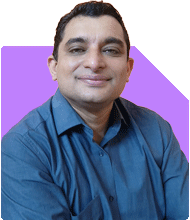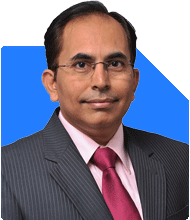Ramalingam Kalirajan |10902 Answers |Ask -Follow
Mutual Funds, Financial Planning Expert - Answered on Jul 11, 2024
He has an MBA in finance from the University of Madras and is a certified financial planner.
He is the director and chief financial planner at Holistic Investment, a Chennai-based firm that offers financial planning and wealth management advice.... more

Hello mam... My income per annually 7lakh ...in fd 24lkh .savings.we have 2kids class 1and daughter is 1year .my savings r in lic 61000 per annum jeevan labh and ppf 12k per year and son ppf account and ssy for daughter i dont have any idea about mutal fund r stock.. Star health 5lkh cover paying 26000premium. 54thousand premium in Maxlife term plan cover for 1cr...please help me how to save for children education
Current Financial Snapshot
You earn Rs. 7 lakhs per annum. You have Rs. 24 lakhs in fixed deposits, which is a good safety net. Your savings in LIC's Jeevan Labh (Rs. 61,000 per annum) and PPF (Rs. 12,000 per year) are commendable. Additionally, you have a PPF account for your son and an SSY account for your daughter, which are excellent long-term savings plans. You also have adequate insurance coverage with Star Health and a Maxlife term plan.
Evaluating Your Current Investments
Your current investments are safe but may not be sufficient for long-term goals like your children's education. Fixed deposits and LIC plans offer safety but relatively low returns compared to other investment options like mutual funds.
Understanding Mutual Funds
Mutual funds can be a powerful tool for long-term wealth creation. They offer a variety of options catering to different risk appetites and investment horizons. Here's why mutual funds can be beneficial for you:
Diversification: Mutual funds invest in a diversified portfolio of assets, reducing risk.
Professional Management: Experienced fund managers handle your investments, aiming to maximize returns.
Potential for Higher Returns: Over the long term, mutual funds, especially equity funds, can offer higher returns than traditional savings options.
Types of Mutual Funds
Here's a brief overview of the different types of mutual funds you can consider:
Equity Funds: These invest primarily in stocks and have the potential for high returns but come with higher risk.
Debt Funds: These invest in fixed income instruments like bonds and are relatively safer but offer lower returns than equity funds.
Hybrid Funds: These invest in a mix of equity and debt, providing a balance of risk and return.
Power of Compounding
Mutual funds benefit from the power of compounding, where your earnings generate their own earnings. The longer you stay invested, the more your investment grows. This is particularly useful for long-term goals like education.
Systematic Investment Plan (SIP)
SIPs allow you to invest a fixed amount regularly in mutual funds. This helps in averaging the cost of investment and reduces the risk of market volatility. It's also easier on your finances as you can start with a small amount and increase it over time.
Creating an Education Fund for Your Children
Now, let's focus on how you can build an education fund for your children using mutual funds:
Set Clear Goals: Estimate the future cost of education. This includes tuition fees, accommodation, books, etc. Consider inflation in your calculations.
Choose the Right Funds: Based on your risk appetite, choose a mix of equity and hybrid funds. Equity funds can be suitable for long-term goals due to their higher return potential. Hybrid funds can provide stability.
Start Early: The earlier you start, the more you benefit from compounding. Even small regular investments can grow significantly over time.
Review and Adjust: Regularly review your investments to ensure they are on track to meet your goals. Adjust your investment amount and fund choices if necessary.
Analyzing Your Risk Appetite
Your investments should align with your risk tolerance. Since you have young children, a long investment horizon allows you to take moderate to high risks initially and then gradually shift to safer options as the goal approaches.
Regular Funds vs Direct Funds
Investing through a certified mutual fund distributor (MFD) with CFP credentials can offer several advantages over direct funds:
Expert Guidance: MFDs provide professional advice tailored to your financial goals.
Regular Monitoring: They continuously monitor your investments and make necessary adjustments.
Personalized Service: You receive personalized service and support, ensuring you stay on track with your investment plan.
Diversification Beyond Mutual Funds
While mutual funds are excellent for long-term goals, consider other diversification options:
Public Provident Fund (PPF): You already have a PPF account. Continue this as it offers tax benefits and guaranteed returns.
Sukanya Samriddhi Yojana (SSY): Continue investing in SSY for your daughter. It's a great scheme with tax benefits and good returns.
Fixed Deposits and Bonds: Maintain some amount in FDs and bonds for safety and liquidity.
Tax Planning
Your investments should also be tax-efficient. Mutual funds, especially Equity Linked Savings Schemes (ELSS), offer tax benefits under Section 80C. Combining these with your existing PPF and SSY contributions can optimize your tax savings.
Emergency Fund
Ensure you have an emergency fund to cover at least 6-12 months of expenses. This can be in the form of liquid funds or a savings account. It provides a safety net during unforeseen circumstances without disrupting your long-term investments.
Final Insights
Your current savings and investments are commendable. By diversifying into mutual funds and leveraging the power of compounding, you can significantly enhance your children's education fund. Remember, regular monitoring and adjustments are key to staying on track with your financial goals. Consulting a Certified Financial Planner can provide personalized advice and ensure you make informed decisions.
Investing wisely today can secure a bright future for your children. All the best!
Best Regards,
K. Ramalingam, MBA, CFP
Chief Financial Planner
www.holisticinvestment.in
You may like to see similar questions and answers below
Ramalingam Kalirajan |10902 Answers |Ask -Follow
Mutual Funds, Financial Planning Expert - Answered on Apr 17, 2024
Ramalingam Kalirajan |10902 Answers |Ask -Follow
Mutual Funds, Financial Planning Expert - Answered on May 25, 2024
Ramalingam Kalirajan |10902 Answers |Ask -Follow
Mutual Funds, Financial Planning Expert - Answered on Jul 25, 2024
Reetika Sharma |429 Answers |Ask -Follow
Financial Planner, MF and Insurance Expert - Answered on Sep 17, 2025
Anu Krishna |1749 Answers |Ask -Follow
Relationships Expert, Mind Coach - Answered on Dec 17, 2025
Anu Krishna |1749 Answers |Ask -Follow
Relationships Expert, Mind Coach - Answered on Dec 17, 2025
Radheshyam Zanwar |6748 Answers |Ask -Follow
MHT-CET, IIT-JEE, NEET-UG Expert - Answered on Dec 17, 2025
Anu Krishna |1749 Answers |Ask -Follow
Relationships Expert, Mind Coach - Answered on Dec 17, 2025
Dr Shakeeb Ahmed Khan |184 Answers |Ask -Follow
Physiotherapist - Answered on Dec 17, 2025
T S Khurana |538 Answers |Ask -Follow
Tax Expert - Answered on Dec 17, 2025
T S Khurana |538 Answers |Ask -Follow
Tax Expert - Answered on Dec 17, 2025
Janak Patel |72 Answers |Ask -Follow
MF, PF Expert - Answered on Dec 17, 2025
Ramalingam Kalirajan |10902 Answers |Ask -Follow
Mutual Funds, Financial Planning Expert - Answered on Dec 17, 2025
Samraat Jadhav |2511 Answers |Ask -Follow
Stock Market Expert - Answered on Dec 17, 2025


























